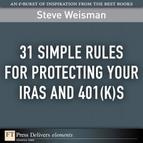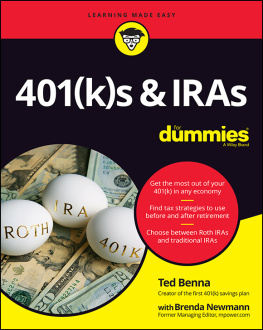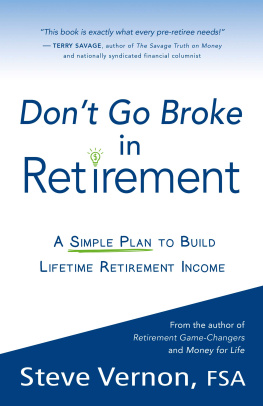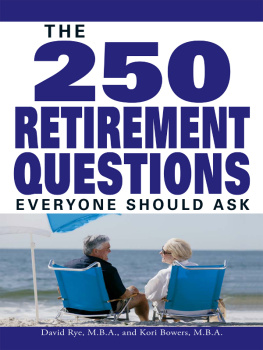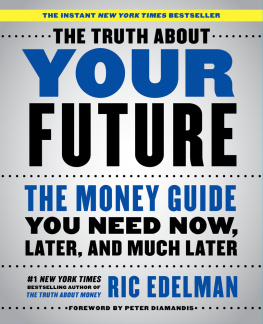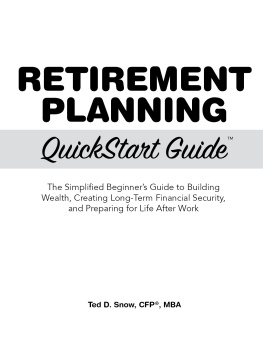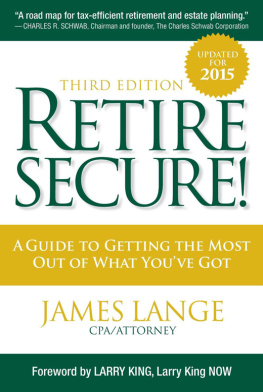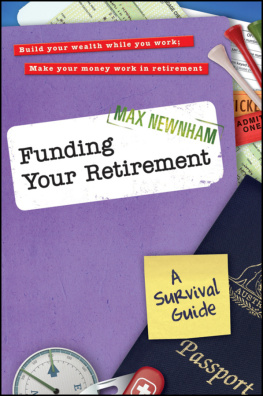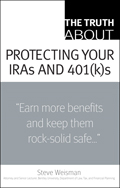
If you liked this Element, you might like the book,
The Truth About Protecting Your IRAs and 401(k)s
(ISBN: 978-0-13-233384-9).

Vice President, Publisher: Tim Moore
Associate Publisher and Director of Marketing: Amy Neidlinger
2010 by Pearson Education, Inc.
Publishing as FTPress Delivers
Upper Saddle River, New Jersey 07458
Company and product names mentioned herein are the trademarks or registered trademarks of their respective owners.
All rights reserved. No part of this book may be reproduced, in any form or by any means, without permission in writing from the publisher.
ISBN-10: 0-13-703975-1
ISBN-13: 978-0-13-703975-3
For more information, please contact us at
When it comes to retirement, the decisions you make earlier in life can go a long way in determining your financial success or failure in retirement and the quality of your retirement experience. Knowing and following a few simple rules can help you make good decisions when it comes to using IRAs and 401(k)s toward a rewarding retirement.
Rule 1:Take your minimum required distributions on time. Many people lose track of when they are required to take their minimum required distributions from their traditional IRAs and traditional 401(k)s. If youre late in taking your initial withdrawals, youll be charged serious penalties. As you approach your seventieth birthday (and hopefully well before then), you should have a plan for how youll most effectively take your minimum required distributions, with an eye toward the income tax ramifications of delaying your first payment to the latest possible time and having to take two distributions in one year.
In addition, in any year that you fail to take your minimum required distribution, you can be subject to a heavy tax penalty, so make sure you keep track of your required distributions.
Rule 2:If you havent paid attention to Rule 1, make sure that you file an IRS Form 5329. Even if you did not take your minimum required distribution in a timely fashion, you can always argue to the IRS that your failure was a reasonable error, correct the problem, and take the required distribution. File a Form 5329 and request a refund of your 50% excess accumulation tax. Include a letter of explanation, and do your best to be persuasive. Youve got nothing to lose.
Rule 3:If you leave a job, dont cash out your 401(k). When you leave your job, you can leave your 401(k) at your company, roll it over into an IRA, roll it over into your new employers 401(k), or take the money and run. The first three options will continue your retirement planning. The last will require you to pay income taxes, stop your tax-deferred growth, and even subject you to a large tax penalty if you are younger than 59-1/2.
Rule 4:Dont borrow from your 401(k) unless you absolutely have to do so. Borrowing from your 401(k) defeats the purpose of the account, limits the amount of growth in the account for retirement, and carries risks of penalties. No one should borrow from their 401(k) unless they have fully explored other options, such as a home equity loan where the interest can be tax deductible.
Rule 5:Make sure that the beneficiary designations of your 401(k)s and IRAs are in good order. Make sure your beneficiary designation is current and reflects any changes you might want to make as to who will be your beneficiaries due to marriages, births, deaths, or divorces.
Rule 6:Make sure that the beneficiary designations of your 401(k)s and IRAs have contingent beneficiaries. To provide the maximum flexibility and enable you to take the fullest advantage of the rules permitting Stretch IRAs, your beneficiary designations must contain the names of contingent beneficiaries.
Rule 7:Reduce the fees that you pay in your 401(k) and IRA as much as possible. The amounts that you pay in various fees for the management of your 401(k) and IRA as well as other services you are billed for in your retirement accounts have a significant effect on what your money will earn for you. Make sure that you understand all the fees you are paying, and take the steps necessary, where possible, to reduce them.
Rule 8:Dont rely on automatic enrollment in your companys 401(k) plan. If you are automatically enrolled in your companys 401(k) plan, the amounts that you contribute and the investments that form the basis of your 401(k) are determined by default. These decisions may not be the ones you would make. Enrollment in a 401(k) plan, whether done automatically or intentionally, is good. But it is a better when you make informed decisions as to how much money youll be investing and where youll be investing it.
Rule 9:For most people, the benefits of a Roth IRA are greater than a traditional IRA.
Rule 10:A traditional 401(k) is better than a Roth IRA if your employer provides matching contributions. There are many fees involved with a traditional IRA, over which you have little or no control, that can limit the growth of your 401(k). With a Roth IRA, you are in a much better position to pick your investments and control your fees. However, if your employer provides matching contributions to your traditional 401(k), that is free money that tips the scales in favor of a traditional 401(k) over a Roth IRA.
Rule 11:Pay off your credit cards before you invest in any retirement plan other than a traditional 401(k) that has employer matching contributions. You will get more bang for your bucks if you pay off your high-interest credit cards before saving for retirement with the one exception of investing in a traditional 401(k) that provides you with the free money of employer matching contributions.
Rule 12:Never invest more than 10% of the value of your 401(k) in your own companys stock. It doesnt make sense to put all your investment eggs in one stock basket regardless of the company. The fact that you work for a particular company already means that youre invested in it. Think Enron. To additionally put a large portion of your 401(k) dollars into the same companys stock is just too risky.
Rule 13:Customize your IRA or 401(k) beneficiary designation as necessary to have it most accurately reflect your estate and financial plan. To have your beneficiary designation be a part of your estate and financial plan, you may have to customize the form to make sure that your wishes are clearly indicated and your options preserved.
Rule 14:Make sure that your heirs are aware of their ability to use qualified disclaimers. A qualified disclaimer when coupled with a properly completed beneficiary designation opens the possibilities of many years of tax savings through the use of Stretch IRAs.
Rule 15:Have a Durable Power of Attorney. A Durable Power of Attorney is a document by which you appoint someone to act on your behalf in financial matters. It is particularly helpful if you are incapacitated and need to change your beneficiary designation or make a disclaimer.
Rule 16:The investment choices that you make within your IRA and 401(k) should be part of an overall asset allocation strategy. A proper asset allocation strategy is the best way to control risk and seek a good return on your retirement investment dollars. The investment choices that you make in your IRA and 401(k) should be part of an overall asset allocation strategy.
Next page
